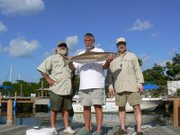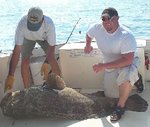Smoked and grilled Mackerel dishes
For more recipes http://www.keysfishingtips.blogspot.com
Here's a few ways to cook all those mackerel that are biting:
Spanish Mackerel have a stigma attached because of Boston mackerel and other mackerel that make good bait and little else. Spanish tastes more like Wahoo than they do like King Mackerel and are very tasty if properly prepared. To prepare Spanish for smoking, I fillet them, leaving the skin on and then zipper the fillets. This is accomplished by cutting down both sides the bone/bloodline in the center of the fillet and pulling the line out. I soak the fillets in salt water and ice for fifteen minutes or so just to make sure the fillets are really chilled and clean.
There are a variety of brining solutions you can use and most of them are great. I rarely brine my fillets before smoking. Normally all I do is season them with salt, pepper, paprika for color and a little cayenne pepper.
I have a fairly elaborate electric smoker that will hold about 150 pounds of fillets that I heat to 250 degrees. In the smoke pot, I use, button wood chips soaked in water and a little apple juice if I have it. Cover you grates with foil and lay the fillets skin side down on the foil. I don’t over cook mine, usually 4 to 6 hours is plenty, depending on the thickness of the fillets. I want the fish cooked but still moist.
Once done, let the fish cool for a while, 5 to 10 minutes, with a large spatula, take the fish off the grate. Most of the skin will stick to the foil making clean up easy.
Smoke mackerel is best served with several cold beer around a cook fire.
Smoke Mackerel Dip
This is my version. There are lots of other great ones.
4 pounds approx. smoked Mackerel crumbled coarsely
1 cup slice green onions
½ cup dice celery
½ cup soften cream cheese
½ cup sour cream
1 package dry ranch dressing mix.
Throw the first five ingredients in a large bowl and blend it all together, clean hands is the best mixer. Sprinkle the dressing mix over it all and mix again. If the smoked fish is properly seasoned, no extra seasoning is required. A little mayo can be added if the fish was smoked a bit dry. The dip should be a little stiff, but should spread with a little difficulty. If you want it to spread more easily, add mayo and/or sour cream.
If you don’t have a smoker or don’t want to smoke the fish, then fire up your grille. Place foil in the center of the grill and place the fish skin side on the foil. I normally mix all my spice in a half cup of mayo and baste the fillets once on the grill at the start of cooking. Cook 10 to 12 minutes over medium heat. Let cool as before and serve with cold beer.
If you have any left over, here’s another good dish:
2 pounds grill Spanish crumbled
2 cups plain bread crumbs
½ cup sliced green onions
½ cup dice bell pepper
1 very finely diced Scot’s bonnet pepper
Garlic and cayenne pepper optional
4 eggs well beaten
Place the fish in a large bowl and punch a well in the middle of the fish.
Put the bread crumbs in the well.
Sauté the peppers and onions in half butter and olive oil (2 table spoons each).
Once translucent, pour the veggies and oil on the bread crumbs. Mix a bit, add the beaten eggs, and mix well.
Get the skillet hot again, with butter and olive oil, and sauté small hamburger size patties of the fish mixture. Cook until crispy on the first side and turn. Cook the second side about half as long as the first. Serve crispy caramelized side up. These are great just like they are, or serve with any creative sauce you like. Duck sauce, honey mustard or hot wing sauce, to name a few. A mango vinaigrette sauce is good with these fish cakes. Just deglaze the skillet with ¼ cup apple vinegar, stir in 1 cup of mango juice and reduce by half over medium low heat.






